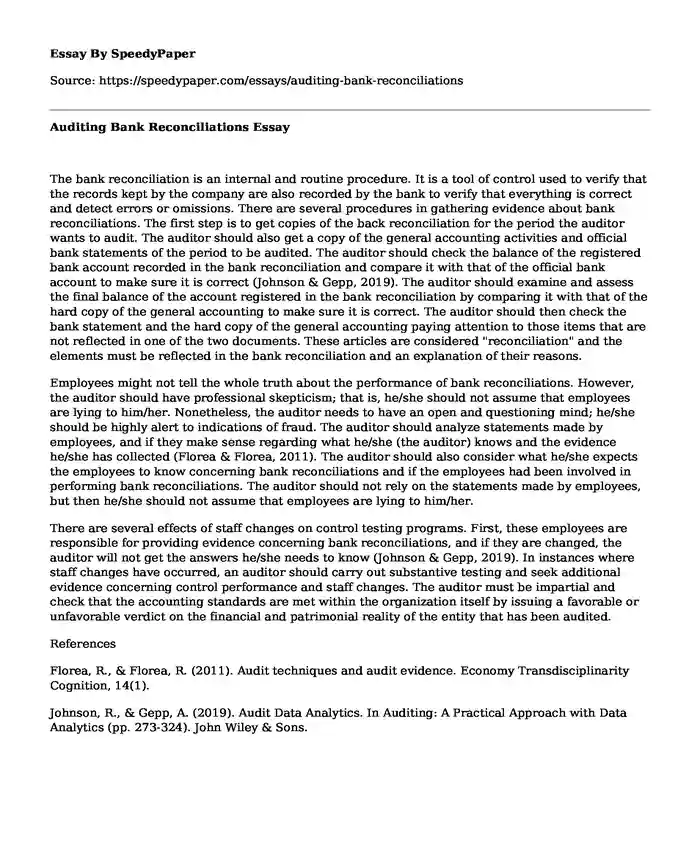
| Type of paper: | Course work |
| Categories: | Policy Analysis Community Civil rights |
| Pages: | 2 |
| Wordcount: | 491 words |
The bank reconciliation is an internal and routine procedure. It is a tool of control used to verify that the records kept by the company are also recorded by the bank to verify that everything is correct and detect errors or omissions. There are several procedures in gathering evidence about bank reconciliations. The first step is to get copies of the back reconciliation for the period the auditor wants to audit. The auditor should also get a copy of the general accounting activities and official bank statements of the period to be audited. The auditor should check the balance of the registered bank account recorded in the bank reconciliation and compare it with that of the official bank account to make sure it is correct (Johnson & Gepp, 2019). The auditor should examine and assess the final balance of the account registered in the bank reconciliation by comparing it with that of the hard copy of the general accounting to make sure it is correct. The auditor should then check the bank statement and the hard copy of the general accounting paying attention to those items that are not reflected in one of the two documents. These articles are considered "reconciliation" and the elements must be reflected in the bank reconciliation and an explanation of their reasons.
Employees might not tell the whole truth about the performance of bank reconciliations. However, the auditor should have professional skepticism; that is, he/she should not assume that employees are lying to him/her. Nonetheless, the auditor needs to have an open and questioning mind; he/she should be highly alert to indications of fraud. The auditor should analyze statements made by employees, and if they make sense regarding what he/she (the auditor) knows and the evidence he/she has collected (Florea & Florea, 2011). The auditor should also consider what he/she expects the employees to know concerning bank reconciliations and if the employees had been involved in performing bank reconciliations. The auditor should not rely on the statements made by employees, but then he/she should not assume that employees are lying to him/her.
There are several effects of staff changes on control testing programs. First, these employees are responsible for providing evidence concerning bank reconciliations, and if they are changed, the auditor will not get the answers he/she needs to know (Johnson & Gepp, 2019). In instances where staff changes have occurred, an auditor should carry out substantive testing and seek additional evidence concerning control performance and staff changes. The auditor must be impartial and check that the accounting standards are met within the organization itself by issuing a favorable or unfavorable verdict on the financial and patrimonial reality of the entity that has been audited.
References
Florea, R., & Florea, R. (2011). Audit techniques and audit evidence. Economy Transdisciplinarity Cognition, 14(1).
Johnson, R., & Gepp, A. (2019). Audit Data Analytics. In Auditing: A Practical Approach with Data Analytics (pp. 273-324). John Wiley & Sons.
Cite this page
Auditing Bank Reconciliations. (2023, Mar 07). Retrieved from https://speedypaper.com/essays/auditing-bank-reconciliations
Request Removal
If you are the original author of this essay and no longer wish to have it published on the SpeedyPaper website, please click below to request its removal:
- Drunk Driving
- Personal Experience Essay Sample: Visit to Tech Museum of Innovation
- Definition Argument Essay Example
- Christmas Day Activities, Essay Sample for Everyone
- A Critical Review Essay of 'Shootings' by Adam Gopnik
- Essay example on Getting ready for the World of Work
- Essay Sample on Customer Service in Airline
Popular categories




